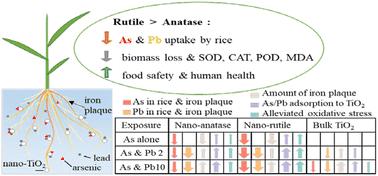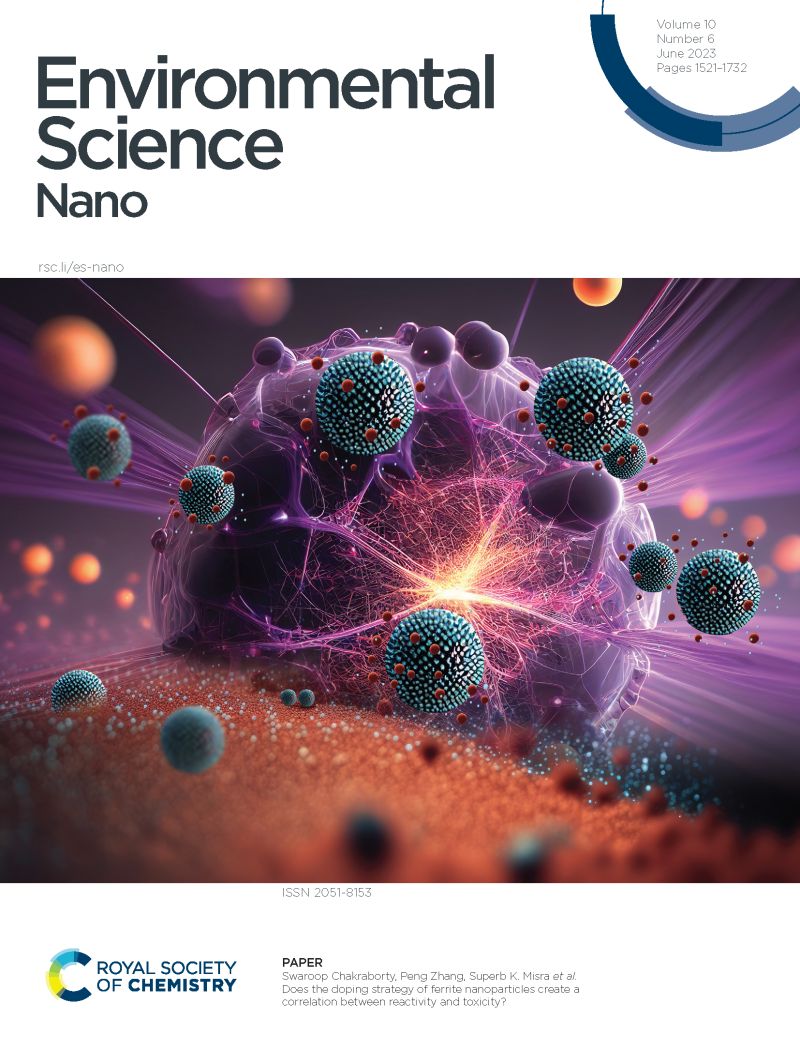纳米tio2同时减少水稻(Oryza sativa L.)中砷和铅的生物积累:机制研究
IF 5.1
2区 环境科学与生态学
Q1 CHEMISTRY, MULTIDISCIPLINARY
引用次数: 0
摘要
带相反电荷的重金属(如砷和铅)通常具有相反的环境行为。同时抑制它们在作物中积累的纳米策略仍然难以捉摸。在本研究中,采用锐钛矿(NAT)或金红石(NRT)结构的纳米TiO2或块状TiO2 (BT)在10、100和1000 mg L - 1浓度下修复被砷(1 mg L - 1)和铅(2或10 mg L - 1)共污染的水培水稻幼苗系统,以了解污染物相互作用的机理。在1000 mg L−1的NAT和NRT中,砷和铅在水稻植株中的生物积累量和在根系铁膜中的滞留量同时减少。NRT对砷摄取的抑制作用(82-93%)远高于NAT(46-65%),而它们对铅摄取的抑制作用相当(NRT为47-89%,NAT为37-78%)。当铅/砷暴露比增加时,100 mg L−1纳米TiO2和BT在所有剂量下也显著降低了根金属含量,这是由于它们对TiO2和铁斑块的吸附增强。TiO2的修正对植物没有任何风险,并且完全减轻了暴露引起的氧化应激,从而使其恢复到健康的控制水平。我们的研究结果强调了1000 mg L−1纳米tio2,特别是具有金红石结构的纳米tio2,在水稻中砷和铅的联合降低方面的潜在应用,有效地提高了食品安全和人类健康。本文章由计算机程序翻译,如有差异,请以英文原文为准。

Simultaneous reduction of arsenic and lead bioaccumulation in rice (Oryza sativa L.) by nano-TiO2: a mechanistic study†
Heavy metals with opposite charges (e.g., arsenic and lead) generally have opposite environmental behaviors. Nano-enabled strategies to concurrently inhibit their accumulation in crops remain elusive. Here, nano-TiO2 with anatase (NAT)...
求助全文
通过发布文献求助,成功后即可免费获取论文全文。
去求助
来源期刊

Environmental Science: Nano
CHEMISTRY, MULTIDISCIPLINARY-ENVIRONMENTAL SCIENCES
CiteScore
12.20
自引率
5.50%
发文量
290
审稿时长
2.1 months
期刊介绍:
Environmental Science: Nano serves as a comprehensive and high-impact peer-reviewed source of information on the design and demonstration of engineered nanomaterials for environment-based applications. It also covers the interactions between engineered, natural, and incidental nanomaterials with biological and environmental systems. This scope includes, but is not limited to, the following topic areas:
Novel nanomaterial-based applications for water, air, soil, food, and energy sustainability
Nanomaterial interactions with biological systems and nanotoxicology
Environmental fate, reactivity, and transformations of nanoscale materials
Nanoscale processes in the environment
Sustainable nanotechnology including rational nanomaterial design, life cycle assessment, risk/benefit analysis
 求助内容:
求助内容: 应助结果提醒方式:
应助结果提醒方式:


